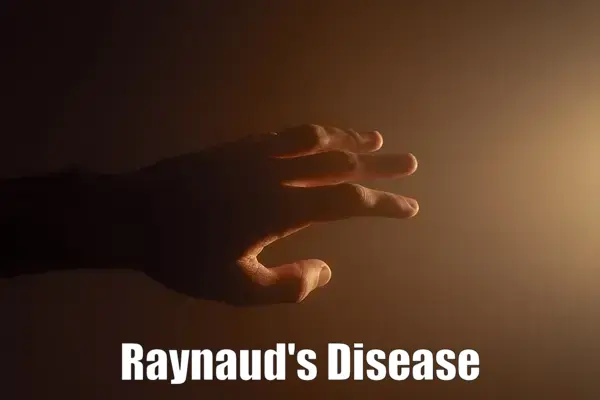Raynaud’s disease, also known as Raynaud’s phenomenon or simply Raynaud’s, is a common condition that affects the blood vessels in our fingers and toes. It is a rare disorder that can cause the blood vessels to narrow down, leading to reduced blood flow, which in turn can cause the affected areas to turn blue or white and feel cold or numb. It primarily affects women more than men and people living in colder climates.
Although there is no cure for Raynaud’s disease, there are treatments available that can help alleviate the symptoms and improve quality of life. In this blog post, we will dive deeper into understanding what Raynaud’s disease is, its causes, symptoms, diagnosis, and treatment options.
What is Raynaud’s Disease and How Does It Affect the Body?
Raynaud’s disease is a condition that affects the blood vessels, causing them to narrow in response to cold temperatures or stress. This restricts blood flow to the affected areas, which can include the fingers, toes, nipples, and ears, leading to symptoms such as numbness, tingling, and skin discoloration. In severe cases, ulcers and gangrene can also develop. Raynaud’s disease can be primary or secondary, with secondary cases often occurring alongside other autoimmune disorders such as rheumatoid arthritis or lupus. There is no cure for Raynaud’s disease, but treatment options such as medication and lifestyle changes can help alleviate symptoms and prevent complications.
Symptoms
- Pale skin: The first symptom of Raynaud’s disease is the affected area turning pale.
- Color changes: During an attack of Raynaud’s, the fingers and toes may change color, ranging from white to blue to red.
- Sensitivity to cold: Patients with Raynaud’s have extreme sensitivity to cold, which often triggers vasospasms.
- Emotional stress: Emotional stress is also known to trigger Raynaud’s attacks.
- Tingling and numbness: Stinging pain, tingling, and numbness in fingers or toes are common symptoms of Raynaud’s disease.
- Sores and tissue damage: In severe cases, loss of blood flow to the affected areas can cause sores or tissue damage.
- Throbbing sensation: Once blood flow returns to the affected area, the skin turns red and a throbbing or tingling sensation may be felt.
- White fingertips: Another symptom of Raynaud’s is white fingertips caused by reduced blood flow to the area.
- Blood vessel restriction: Raynaud’s disease is caused by blood vessel narrowing or restriction in the extremities.
- Commonly affects fingers and toes: Raynaud’s phenomenon usually affects the fingers and toes, but can also affect the nose, ears, and lips.
So, Raynaud’s disease can cause a wide range of symptoms, from color changes and numbness to sores and tissue damage. It is important to seek medical attention if any of these symptoms are experienced, especially if they occur frequently or severely.
Causes
- Cold temperatures: One of the most common triggers of Raynaud’s disease is cold temperatures. When exposed to cold, the blood vessels in the fingers and toes of people with the condition tend to narrow, leading to restricted blood flow.
- Stress and anxiety: Anxiety and stress can also trigger Raynaud’s disease. When a person is under stress, their body releases hormones that cause the blood vessels to constrict and restrict blood flow.
- Underlying health conditions: Raynaud’s disease can be caused by other health conditions, such as lupus, scleroderma, or connective tissue diseases. In these cases, the disease is referred to as secondary Raynaud’s.
- Medications: Some medications, such as beta blockers, can cause Raynaud’s disease as a side effect. It’s important to talk to a healthcare provider about any medications that may be causing the symptoms.
- Vibrating tools: People who work with vibrating tools for long periods of time may develop Raynaud’s disease. The constant vibration can cause damage to the blood vessels in the fingers and toes, leading to restricted blood flow.
Overall, it’s important for anyone experiencing symptoms of Raynaud’s disease to see a healthcare provider for an accurate diagnosis and treatment options.
Risk Factors
- Gender: Females are more likely to develop Raynaud’s disease than males.
- Family history: Having a family history of Raynaud’s disease increases the risk of developing the condition.
- Age: The risk of developing secondary Raynaud’s typically increases with age, with onset after the age of 30.
- Smoking: Cigarette smoking is a major risk factor for Raynaud’s disease, and those who smoke are at a higher risk of developing the condition.
- Connective tissue diseases: Individuals with connective tissue diseases, such as scleroderma and lupus, are at a higher risk of developing Raynaud’s disease.
- Migraines: Migraine sufferers have a higher risk of developing Raynaud’s disease.
- Stress and anxiety: Stress and anxiety have been known to trigger Raynaud’s attacks, and may increase the risk of developing the disease.
Understanding these risk factors can help individuals take steps to prevent or manage Raynaud’s disease. It is important to speak with a healthcare provider to discuss any symptoms or concerns regarding the condition.
Diagnosis
New research studies have shown that diagnosing Raynaud’s disease can be difficult, as there is no one single test that can diagnose the condition. Raynaud’s phenomenon is a disorder that causes blood vessels in the fingers and toes to narrow, leading to reduced blood flow and discoloration of the skin. Symptoms of the condition can range from mild to severe and can include numbness, tingling, and pain.
Healthcare providers typically diagnose Raynaud’s syndrome based on a patient’s symptoms and a physical examination. Patients may be asked to take photos of their skin changes, and doctors may perform a cold stimulation test by placing the patient’s hands or feet in an ice water bath to see if the characteristic symptoms appear.
According to recent guidelines from the American College of Rheumatology, rheumatologists are the best-equipped doctors to diagnose Raynaud’s phenomenon. A medical history and physical exam are the starting points for diagnosing the condition, and patients may also undergo blood tests to rule out other conditions that share similar symptoms.
Patients with primary Raynaud’s typically have a normal examination and blood work, while those with secondary Raynaud’s may have abnormalities in the arteries or other underlying health conditions. While there is no cure for Raynaud’s, early diagnosis and treatment can help manage symptoms and prevent complications.
If you experience symptoms of Raynaud’s, it is important to seek medical attention and receive a proper diagnosis to ensure the condition is properly managed. With the help of healthcare professionals, patients with Raynaud’s can learn to manage their symptoms and improve their quality of life.
Treatment Options
Treatment for Raynaud’s disease varies depending on the severity of the condition. A variety of medications can be used to alleviate symptoms, including calcium channel blockers and prostacyclin analogues. For severe cases, a sympathectomy may be recommended.
Those with Raynaud’s disease should also be aware of the potential link between the condition and other autoimmune disorders, and work with their healthcare provider to monitor any potential underlying illnesses.
Ultimately, treatment options for Raynaud’s disease should be tailored to each individual’s unique needs and circumstances.
Medications and lifestyle changes that can alleviate symptoms
Medications and lifestyle changes can go a long way in alleviating the symptoms of Raynaud’s disease. While there is no cure, those with mild and infrequent attacks can manage their condition by avoiding triggers such as cold temperatures and vasoconstricting drugs.
Smoking cessation is also recommended. For moderate to severe cases, calcium channel blockers such as nifedipine and amlodipine are commonly prescribed as first-line medications. These drugs help dilate blood vessels and improve blood flow to the fingers and toes. If medications and lifestyle changes fail, vascular surgery consultation may be necessary for sympathectomy.
It is essential to work closely with a primary care physician or rheumatologist to develop a personalized treatment plan that suits one’s needs.
Surgical options for severe cases
In severe cases, where medication and lifestyle changes fail to alleviate symptoms of Raynaud’s disease, surgical interventions are necessary. Surgical options include sympathetic blockade and thoracoscopic sympathectomy. These procedures work by interrupting the nerve signals that cause the blood vessels in the hands and feet to narrow, thus preventing digital ischemia.
The decision to undergo surgery is made only when other treatment methods fail or are poorly tolerated. A multidisciplinary team of medical specialists, including vascular medicine, rheumatology, pulmonary vascular, and plastic surgery, collaborate to determine the most appropriate surgical intervention for each patient.
Overall, surgical options are considered safe and effective in treating severe cases of Raynaud’s disease.
Alternative therapies and natural remedies to consider
Alternative therapies and natural remedies can be effective in reducing the symptoms of Raynaud’s disease. Among the natural remedies, gingko biloba is the most researched herb and has shown significant effects in alleviating Raynaud’s symptoms. Fish oil and vitamin E supplements are beneficial in improving blood flow and reducing symptoms caused by vibrating tools or equipment.
The Link Between Raynaud’s Disease and Other Autoimmune Disorders
A recent study has found that Raynaud’s phenomenon, a condition where cold temperatures or strong emotions cause blood vessel spasms leading to restricted blood flow to the fingers, toes, and other extremities, is closely linked to autoimmune disorders such as lupus and scleroderma. These conditions have an increased prevalence in individuals suffering from Raynaud’s, and the symptoms of Raynaud’s can often be a presenting manifestation of an underlying autoimmune disease.
The study shows that people with pre-existing autoimmune diseases are at an increased risk of developing Raynaud’s phenomenon. Additionally, older age at onset of symptoms of Raynaud’s may indicate a potential autoimmune disorder. Environmental factors such as smoking, exposure to vibration, and use of certain medications may also increase the risk of developing the condition.
It is important for individuals experiencing symptoms of Raynaud’s, such as cold fingers or toes, skin discoloration, and numbness or tingling, to seek medical attention for a proper diagnosis. Early diagnosis and treatment of underlying autoimmune disorders can prevent complications and improve outcomes for patients.
Doctors and healthcare professionals are encouraged to consider autoimmune disorders when diagnosing and treating patients with Raynaud’s phenomenon, as prompt intervention can prevent long-term damage to affected tissues and organs.
In conclusion, the link between Raynaud’s phenomenon and autoimmune disorders highlights the need for awareness of the potential underlying causes of this condition. Individuals should not ignore symptoms of Raynaud’s, and medical professionals should be vigilant in screening for autoimmune diseases in patients with this condition. With early diagnosis and appropriate treatment, patients can experience improved quality of life and better health outcomes.

About the Author
Reyus Mammadli is the author of this health blog since 2008. With a background in medical and biotechnical devices, he has over 15 years of experience working with medical literature and expert guidelines from WHO, CDC, Mayo Clinic, and others. His goal is to present clear, accurate health information for everyday readers — not as a substitute for medical advice.






